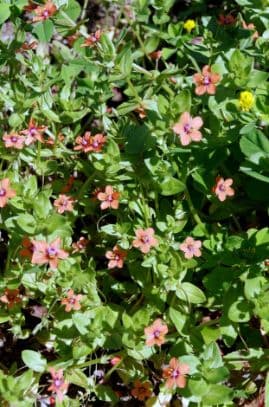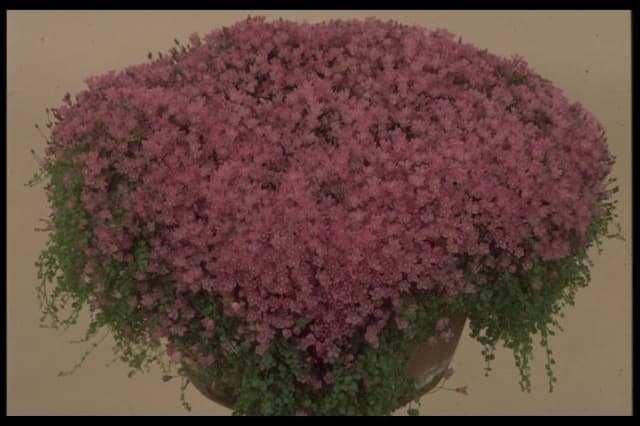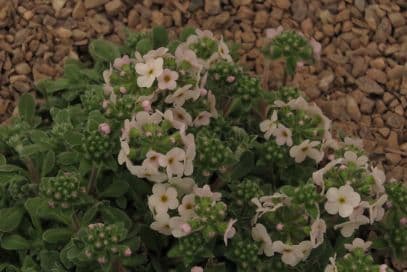Japanese Primrose Primula sieboldii 'Mikado' (Co)

ABOUT
The 'Mikado' cultivar of the Japanese Primrose is a flowering plant that features a stunning display of blooms. The flowers are noteworthy for their vibrant and striking colors ranging from white, pink to deep magenta hues. Each blossom consists of five petals that fan out from the center, often showcasing a gradient of color that intensifies as it reaches the petal margins. In the heart of the flower, one can typically observe a bright yellow or sometimes white eye, giving the plant a sharp contrast and drawing attention to the center. The petals have a delicate, rounded shape, some with a subtle notch at the tip, which adds to the ornate look of the flower. They may also exhibit faint veining, which can be more or less pronounced depending on the individual flower. The overall arrangement of the petals gives the blooms a crimped or frilly appearance, enhancing the plant's decorative charm. The leaves of this variation of Japanese Primrose are typically broad with a deep green color and have a rounded or heart-shaped appearance with scalloped or slightly toothed edges. The foliage forms a lush, verdant backdrop for the flowers, which rise above the leaves on slender, sturdy stems. The plant's growth habit is to form a clump, with the flowers densely arranged, creating an eye-catching display of color and texture. This ornamental appeal makes the 'Mikado' Japanese Primrose a sought-after addition for gardeners looking to introduce a touch of grace and vivid color to shady garden spots or along pond edges, where the plant's aesthetic qualities can be fully enjoyed.
About this plant
 Names
NamesSynonyms
Siebold's Primrose, Japanese Primrose, Mikado Primrose.
Common names
Primula sieboldii 'Mikado' (Co).
 Toxicity
ToxicityTo humans
Primula sieboldii, commonly known as the Siebold's primrose, is not typically considered toxic to humans. There is no widely recognized toxicity associated with this plant, and ingesting any part of it is not commonly reported to cause adverse effects in humans. Therefore, there are no specific symptoms of poisoning associated with Siebold's primrose to describe.
To pets
Siebold's primrose is not commonly known to be toxic to pets either. This plant is not listed as poisonous for domestic animals, so ingestion of parts of Siebold's primrose by pets is unlikely to result in serious poisoning. However, it's always a good practice to discourage pets from eating plants as individual animals might have specific sensitivities or could experience gastrointestinal upset from eating non-food items.
 Characteristics
CharacteristicsLife cycle
Perennials
Foliage type
Deciduous
Color of leaves
Varies
Flower color
Pink
Height
0.5 feet (15 cm)
Spread
0.5 feet (15 cm)
Plant type
Herb
Hardiness zones
4
Native area
Asia
Benefits
 General Benefits
General Benefits- Ornamental Value: Adds aesthetic beauty to gardens and landscapes with its attractive flowers.
- Pollinator Attraction: By producing nectar, it attracts bees, butterflies, and other pollinators that are essential for ecosystem health.
- Shade Tolerance: Capable of growing in partially shaded conditions, offering flexibility in garden design.
- Seasonal Interest: Offers vibrant color in springtime, enhancing seasonal variety in the garden.
- Hardiness: Exhibits resilience in the right conditions, making it suitable for cultivation in many temperate regions.
- Low Maintenance: Requires minimal care once established, making it an easy choice for gardeners of all levels.
 Medical Properties
Medical PropertiesThis plant is not used for medical purposes.
 Air-purifying Qualities
Air-purifying QualitiesThis plant is not specifically known for air purifying qualities.
 Other Uses
Other Uses- Edible Flower Garnish: The flowers of the Japanese Primrose can be used to add a colorful touch to salads and desserts.
- Eco-Friendly Confetti: Dried petals of the Japanese Primrose can be utilized as a biodegradable confetti alternative for celebrations.
- Natural Fabric Dyes: The pigments of the Japanese Primrose flowers can be used for dyeing fabrics in shades of pink and purple.
- Plant-Inspired Artwork: Artists may use the distinct appearance of Japanese Primrose as inspiration for paintings, illustrations, and textile designs.
- Culinary Flavoring: The mild flavor of the Japanese Primrose petals can be infused into syrups, jellies, or homemade ice creams.
- Botanical Photography: With its striking blooms, Japanese Primrose is an excellent subject for botanical photography and macro imagery.
- Floral Arranging: The Japanese Primrose can add diversity and a touch of elegance to mixed floral arrangements and bouquets.
- Specialty Crafts: Dried blooms of the Japanese Primrose can be incorporated into craft projects like making homemade paper or potpourri.
- Cake Decoration: Fresh or crystallized Japanese Primrose flowers can adorn cakes and pastries for special occasions.
- Education and Science: Botanical studies and horticultural classes often include Japanese Primrose as a case study for plant propagation and hybridization.
Interesting Facts
 Feng Shui
Feng ShuiThe Primrose is not used in Feng Shui practice.
 Zodiac Sign Compitability
Zodiac Sign CompitabilityThe Primrose is not used in astrology practice.
 Plant Symbolism
Plant Symbolism- Hope: Primula sieboldii, commonly known as Siebold's primrose, often blooms early in the spring, symbolizing hope and the return of happiness after a long winter.
- New Beginnings: Its emergence in the early spring months is a symbol of new beginnings and starting afresh, often tied to personal growth or new ventures.
- Youth: The delicate and vibrant flowers of the Siebold's primrose are reminiscent of youth and vitality, symbolizing innocence and the playful spirit of the young.
- Constancy: The plant's ability to return each year and bloom reliably can be seen as a symbol of steadfastness and constancy in love and friendships.
 Water
WaterJapanese Primrose should be watered regularly to maintain evenly moist soil, especially during the growing season. Aim to water this plant roughly once every three to five days, depending on the environment’s humidity and temperature. When watering, provide enough water to soak the soil without leaving the plant standing in water. As a guideline, this will typically be around 1-2 gallons spread out during the week for an outdoor garden setting, adjusting as necessary to prevent waterlogging.
 Light
LightJapanese Primrose thrives in partial shade where it can receive filtered sunlight or a few hours of direct morning sun. It's best to place them in a spot that is shielded from the harsh afternoon sun to avoid scorching their delicate leaves. An ideal location would be under a tree canopy or on the east side of a building where the plant can enjoy bright but indirect light.
 Temperature
TemperatureJapanese Primrose prefers cool to moderate temperatures, ideally between 60 and 75 degrees Fahrenheit. They are hardy in temperatures as low as -20 degrees Fahrenheit but should be protected from frost to prevent damage. The plant can withstand brief periods of higher temperatures, but sustained heat can be detrimental to its health.
 Pruning
PruningPrune Japanese Primrose after blooming to remove spent flowers and encourage a tidy appearance. This typically means pruning them once a year in late spring or early summer. Deadheading, or the removal of faded flowers, can also promote a second bloom in some climates. Use sharp, clean shears for the task to reduce the risk of disease transmission.
 Cleaning
CleaningAs needed
 Soil
SoilThe best soil mix for Japanese Primrose (Primula sieboldii 'Mikado') should be rich, moist, well-draining, and humusy with a pH ranging from 6.0 to 7.0. A mixture of peat, garden soil, and perlite or sand in equal parts can be ideal. Adding some organic matter such as compost will help retain moisture and provide nutrients.
 Repotting
RepottingJapanese Primrose should be repotted every 1-2 years or when it becomes root-bound. It is best to repot in the late winter or early spring, just before the new growth starts. This helps the plant to establish in its new container before the growing season begins.
 Humidity & Misting
Humidity & MistingJapanese Primrose thrives in moderate to high humidity. It is ideal to maintain a humidity level of 50% or higher for optimal growth. If the air is too dry, especially indoors, a humidifier or pebble tray with water can help increase the surrounding humidity.
 Suitable locations
Suitable locationsIndoor
Keep in cool, well-lit spot with moist soil.
Outdoor
Plant in dappled shade, enrich soil, keep moist.
Hardiness zone
4-8 USDA
 Life cycle
Life cycleJapanese Primrose 'Mikado' (Primula sieboldii 'Mikado') begins its life as a seed, which upon germinating in the spring, develops into a small seedling with characteristic basal leaves. As the plant matures, it forms a rosette of crinkled, bright green leaves from which emerges a flowering stalk bearing clusters of vibrantly colored flowers, typically in shades of pink and purple, in late spring to early summer. After pollination, often by insects attracted to its flowers, the plant produces small capsules containing numerous tiny seeds. Once the seeds are dispersed, the plant enters a period of dormancy in late summer, with foliage dying back to the ground. During dormancy, the plant survives as a rootstock underground which stores energy for the next growth cycle. With the return of favorable conditions in the following spring, the Japanese Primrose resumes growth from the rootstock, completing its perennial life cycle.
 Propogation
PropogationPropogation time
Spring-Early Summer
Propogation: Primula sieboldii 'Mikado', commonly known as Japanese Primrose, is typically propagated by division, which is the most popular method for this species. The best time to divide the plant is in the late summer or early fall after it has finished flowering. Dividing the plant involves gently lifting the entire clump from the ground with a spade or a garden fork and then carefully separating the clump into smaller sections, each with several leaves and its own root system. Once divided, the sections can be replanted immediately into well-prepared soil that is rich in organic matter, ensuring that they are spaced about 8 to 12 inches (approximately 20 to 30 centimeters) apart to allow enough room for growth. Watering thoroughly after replanting is essential to help establish the new divisions.









